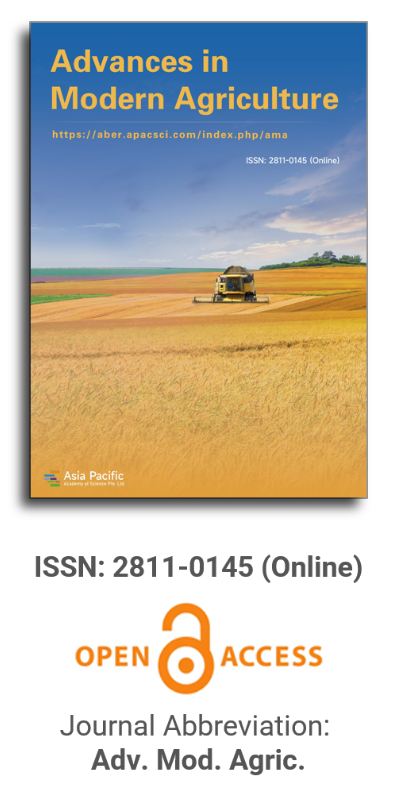


Organomineral foliar application modulates photosynthetic pigments and biochemical responses in black mung bean
Vol 6, Issue 2, 2025
VIEWS - 454 (Abstract)
Download PDF
Abstract
The use of organomineral products in agriculture offers promising solutions for crop productivity and sustainability. This study examines the effects of foliar application of a biostimulant containing Ascophyllum nodosum algae extract and a blend of amino acids on black mung bean (Vigna radiata L.), focusing on its potential to modulate beneficial biochemical responses. Under greenhouse conditions, total chlorophyll content was 20% higher (198 µg/g) in treated plants than in untreated controls (167 µg/g). Carotenoid concentrations were also higher (115 µg/g) in treated plants compared to 98 µg/g in the control plants. Considering redox system enzymes, catalase (4180 nmol/µg), peroxidase (6656 nmol/µg), and superoxide dismutase (5546 nmol/µg) activities were lower in treated plants compared to untreated ones (6982 nmol/µg for catalase, 9635 nmol/µg for peroxidase, and 10,403 nmol/µg for superoxide dismutase). However, given the higher levels of photosynthetic pigments observed in treated plants, antioxidant activity may be primarily attributed to non-enzymatic mechanisms, such as carotenoids, which were also elevated relative to controls. These findings demonstrate the potential of the organomineral as a tool for the physiological management of agriculturally important crops, particularly black mung bean. In this context, its adoption holds the potential to significantly improve agricultural productivity and crop resilience.
Keywords
References
1. Kaewwongwal A, Kongjaimun A, Somta P, et al. Genetic diversity of the blackgram [Vigna mungo (L.) Hepper] gene pool as revealed by SSR markers. Breeding Science. 2015; 65(2): 127–137. doi: 10.1270/JSBBS.65.127
2. Nair RM, Chaudhari S, Devi N, et al. Genetics, genomics, and breeding of black gram [Vigna mungo (L.) Hepper]. Frontiers in Plant Science. 2024; 14. doi: 10.3389/fpls.2023.1273363
3. Instituto Brasileiro de Feijão e Pulses. All about mung beans (Portuguese). Available online: https://www.ibrafe.org/artigo/tudo-sobre-feijao-mungo (accessed on 14 February 2025).
4. Ma Y, Freitas H, Dias MC. Strategies and prospects for biostimulants to alleviate abiotic stress in plants. Frontiers in Plant Science. 2022; 13: 1–15.
5. Deolu‐Ajayi AO, van der Meer IM, van der Werf A, Karlova R. The power of seaweeds as plant biostimulants to boost crop production under abiotic stress. Plant, Cell & Environment. 2022; 45(9): 2537–2553. doi: 10.1111/pce.14391
6. Du Jardin P. Plant biostimulants: Definition, concept, main categories and regulation. Scientia Horticulturae. 2015; 196: 3–14. doi: 10.1016/j.scienta.2015.09.021
7. de Souza Silva J, da Costa RS, Rodrigues CYAC, et al. The application of a biostimulant based on Ascophyllum nodosum, fulvic acid and nutrients mitigates water deficit in soybean. Australian Journal of Crop Science. 2023; 17(7): 539–548.
8. de Mello Frasca LL, Nascente AS, Lanna AC, et al. Biostimulants on plant growth and agronomic performance of super-early-cycle common beans (Portuguese). Agrarian. 2020; 13(47): 27–41.
9. da Silva Cavalcante WS, da Silva NF, Teixeira MB, et al. Efficiency of biostimulants in managing water deficit in soybean crops (Portuguese). Irriga. 2020; 25(4): 754–763.
10. Crouch IJ, Van Staden J. Evidence for rooting factors in a seaweed concentrate prepared from Ecklonia maxima. Journal of Plant Physiology. 1994; 137(3): 319–322.
11. Jannin L, Arkoun M, Etienne P, et al. Brassica napus growth is promoted by Ascophyllum nodosum (L.) Le Jol. seaweed extract: Microarray analysis and physiological characterization of N, C, and S metabolisms. Journal of Plant Growth Regulation. 2013; 32(1): 31–52.
12. Wally OSD, Critchley AT, Hiltz D, et al. Regulation of phytohormone biosynthesis and accumulation in Arabidopsis following treatment with commercial extract from the marine macroalga Ascophyllum nodosum. Journal of Plant Growth Regulation. 2013; 32(2): 324–339. doi: 10.1007/s00344-012-9301-9
13. Shukla PS, Mantin EG, Adil M, et al. Ascophyllum nodosum-based biostimulants: Sustainable applications in agriculture for the stimulation of plant growth, stress tolerance, and disease management. Frontiers in Plant Science. 2019; 10: 462648. doi: 10.3389/fpls.2019.00655
14. Carvalho FP. Pesticides, environment, and food safety. Food and Energy Security. 2017; 6(2): 48–60. doi: 10.1002/fes3.108
15. Mittler R. Oxidative stress, antioxidants, and stress tolerance. Trends in Plant Science. 2002; 7(9): 405–410.
16. Apel K, Hirt H. Reactive oxygen species: Metabolism, oxidative stress, and signal transduction. Annual Review of Plant Biology. 2004; 55(1): 373–399.
17. Tuteja N. Mechanisms of high salinity tolerance in plants. In: Hirt H (editor). Methods in Enzymology: Osmosensors and Osmosignaling, 1st ed. Academic Press; 2007. Volume. 428. pp. 419–438.
18. Tuteja N. Cold. Salt and drought stress. In: Hirt H (editor). Plant Stress Biology: From Genomics Towards System Biology. Wiley-Blackwell; 2010. pp. 137–159.
19. Lichtenthaler HK, Buschmann C. Chlorophylls and carotenoids: Measurement and characterization by UV-VIS spectroscopy. In: Wrolstad RE (editor). Current Protocols in Food Analytical Chemistry. John Wiley & Sons; 2001. pp. 431–438.
20. Hong DD, Hien HM, Son PN. Seaweeds from Vietnam used for functional food, medicine, and biofertilizer. Journal of Applied Phycology. 2007; 19(6): 817–826.
21. Pise NM, Sabale AB. Effect of seaweed concentrates on the growth and biochemical constituents of Trigonella foenum-graecum L. Journal of Phytology. 2010; 2(4): 50–56.
22. Selvam GG, Sivakumar K. Effect of foliar spray from seaweed liquid fertilizer of Ulva reticulata (Forsk.) on Vigna mungo L. and their elemental composition using SEM–Energy dispersive spectroscopic analysis. Asian Pacific Journal of Reproduction. 2013; 2(2): 119–125.
23. Tandon S, Dubey A. Effects of Biozyme (Ascophyllum nodosum) biostimulant on growth and development of soybean (Glycine max (L.) Merrill). Communications in Soil Science and Plant Analysis. 2015; 46(7): 845–858.
24. Jadhao GR, Chaudhary DR, Khadse VA, Zodape ST. Utilization of seaweeds in enhancing productivity and quality of black gram [Vigna mungo (L.) Hepper] for sustainable agriculture. Indian Journal of Natural Products and Resources. 2015; 6(1): 16–22.
25. El-Sharkawy M, El-Beshsbeshy T, Al-Shal R, Missaoui A. Effect of plant growth stimulants on alfalfa response to salt stress. Agricultural Science. 2017; 8(4): 267–291.
26. Verma N, Sehrawat KD, Mundlia P, et al. Potential use of Ascophyllum nodosum as a biostimulant for improving the growth performance of Vigna aconitifolia (Jacq.) Marechal. Plants. 2021; 10(11): 2361. doi: 10.3390/plants10112361
27. Foyer CH, Noctor G. Redox homeostasis and antioxidant signaling: A metabolic interface between stress perception and physiological responses. The Plant Cell. 2005; 17(7): 1866–1875.
28. Valko M, Rhodes CJ, Moncol J, et al. Free radicals, metals, and antioxidants in oxidative stress-induced cancer. Chemical Biology and Interactions. 2006; 160(1): 1–40.
29. Gill SS, Tuteja N. Reactive oxygen species and antioxidant machinery in abiotic stress tolerance in crop plants. Plant Physiology and Biochemistry. 2010, 48(12): 909–930. doi: 10.1016/j.plaphy.2010.08.016
30. Collins A. Carotenoids and genomic stability. Mutation research. 2001; 475(1–2): 21–28.
31. Kumari S, Sehrawat KD, Phogat D, et al. Ascophyllum nodosum (L.) Le Jolis, a pivotal biostimulant toward sustainable agriculture: a comprehensive review. Agriculture. 2023; 13(6): 1179. doi: 10.3390/agriculture13061179
32. Hussain HI, Kasinadhuni N, Arioli T. The effect of seaweed extract on tomato plant growth, productivity and soil. Journal of Applied Phycology. 2021; 33(2): 1305–1314.
33. Ali O, Ramsubhag A, Jayaraman J. Biostimulatory activities of Ascophyllum nodosum extract in tomato and Sweet pepper crops in a tropical environment. PLoS ONE. 2019; 14(5): e0216710.
34. de Jesus JF, Santos AS, de Sousa RO, et al. Ascophyllum nodosum-derived biostimulant promotes physiological conditioning to increase soybean yield in a semiarid climate. Journal of Applied Phycology. 2024; 36(6): 3755–3768. doi: 10.1007/s10811-024-03365-0
Supporting Agencies
Copyright (c) 2025 Author(s)
License URL: https://creativecommons.org/licenses/by/4.0/

This site is licensed under a Creative Commons Attribution 4.0 International License (CC BY 4.0).

Prof. Zhengjun Qiu
Zhejiang University, China

Cheng Sun
Academician of World Academy of Productivity Science; Executive Chairman, World Confederation of Productivity Science China Chapter, China
Indexing & Archiving
In the realm of modern agriculture, the integration of cutting-edge technologies is revolutionizing the way we approach sustainable farming practices. A recent study published in Advances in Modern Agriculture titled "Classification of cotton water stress using convolutional neural networks and UAV-based RGB imagery" has garnered significant attention for its innovative approach to precision irrigation management. Conducted by researchers from Institute of Data Science and the AgriLife Research and Extension Center of Texas A&M University (authors's information is below). This study introduces a novel method for classifying cotton water stress using unmanned aerial vehicles (UAVs) and convolutional neural networks (CNNs), offering a powerful solution for optimizing water use in agriculture.
Modern agricultural technology is evolving rapidly, with scientists collaborating with leading agricultural enterprises to develop intelligent management practices. These practices utilize advanced systems that provide tailored fertilization and treatment options for large-scale land management.
This journal values human initiative and intelligence, and the employment of AI technologies to write papers that replace the human mind is expressly prohibited. When there is a suspicious submission that uses AI tools to quickly piece together and generate research results, the editorial board of the journal will reject the article, and all journals under the publisher's umbrella will prohibit all authors from submitting their articles.
Readers and authors are asked to exercise caution and strictly adhere to the journal's policy regarding the usage of Artificial Intelligence Generated Content (AIGC) tools.
Asia Pacific Academy of Science Pte. Ltd. (APACSCI) specializes in international journal publishing. APACSCI adopts the open access publishing model and provides an important communication bridge for academic groups whose interest fields include engineering, technology, medicine, computer, mathematics, agriculture and forestry, and environment.



.jpg)
.jpg)

.jpg)
